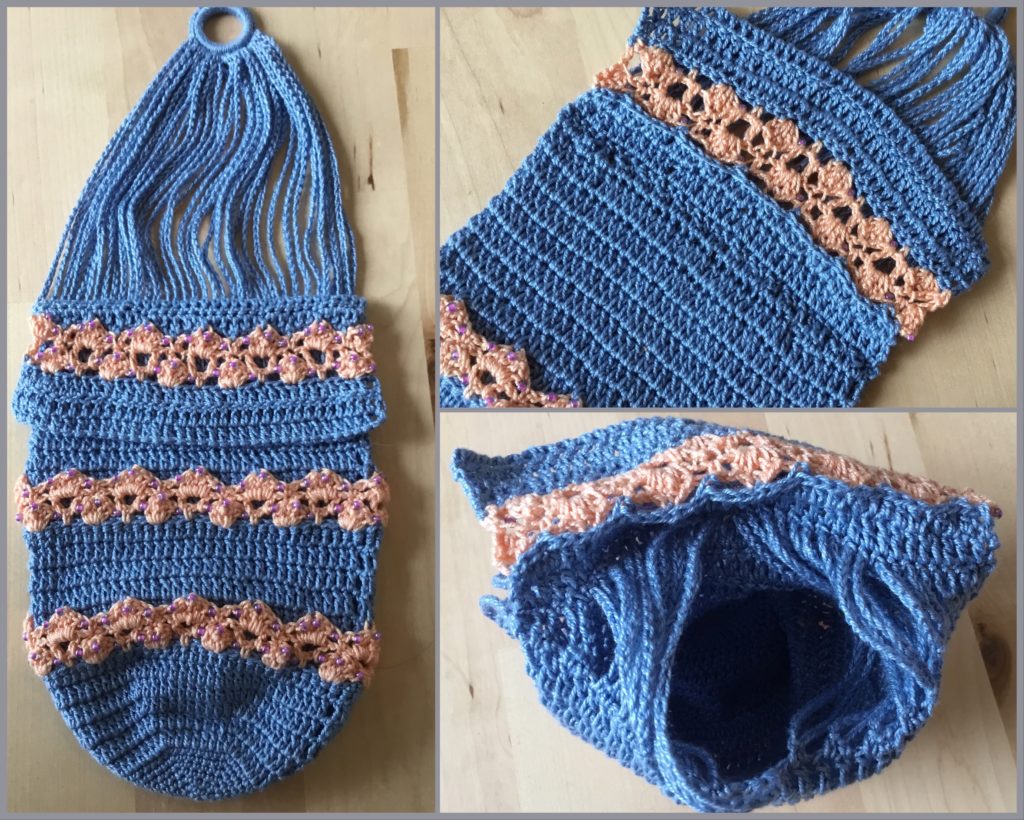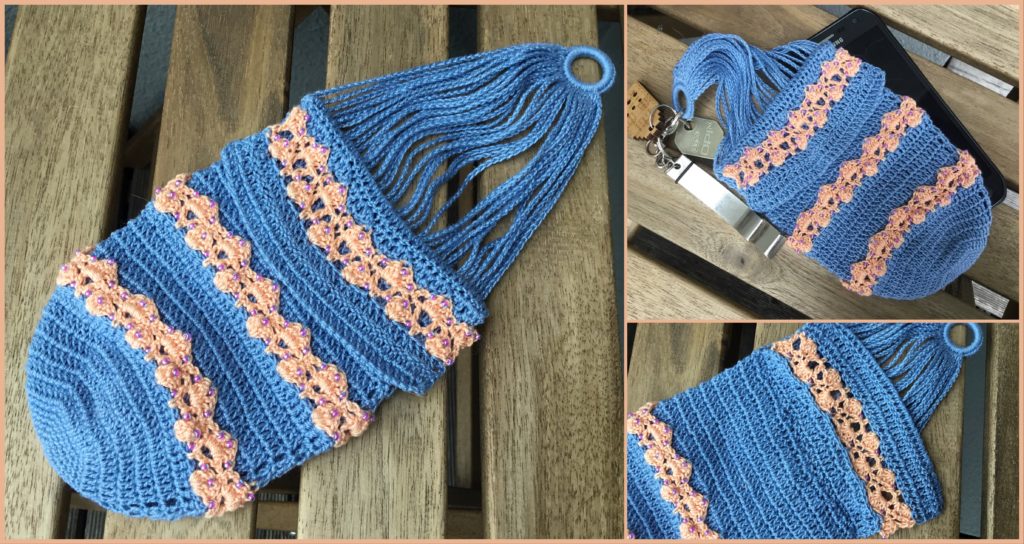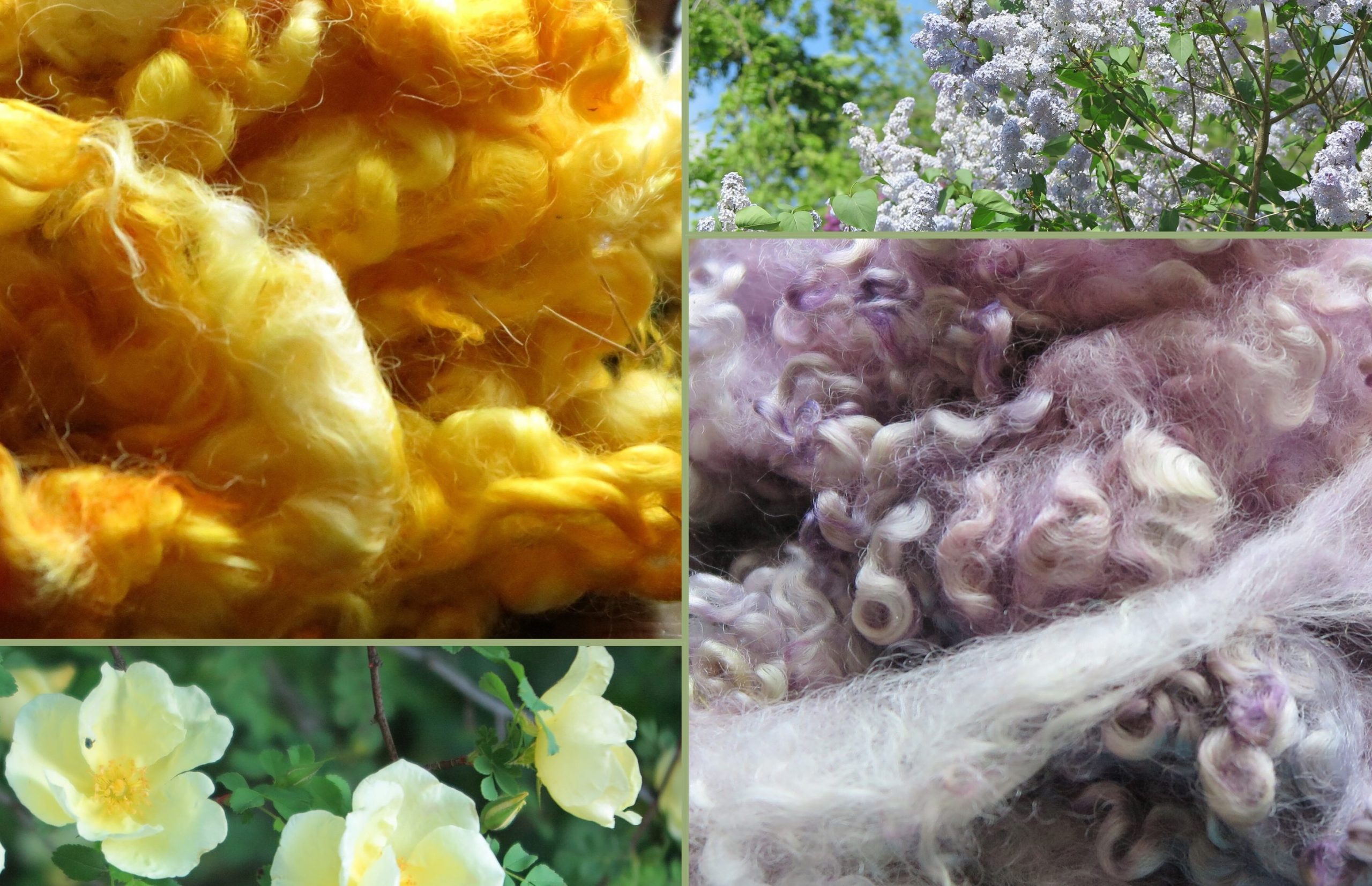
I was first exposed to the concept of “Misers’ purses” through the DMC booklet Magical Misers Purses. At first glance, the purse may appear sewn shut, but as you pull the front and back apart, it becomes clear that the row of chains is not merely decorative: they hold the purse closed until pulled through small gaps to open it.
This style dates to Victorian times, and the DMC booklet is a set of modern patterns based on the method. I made one of the patterns in it as a child, and then again more recently when I picked up crochet again a few years ago. However, I left the book back in the United States in storage because I didn’t think I’d need it.
We were discussing crochet and knitted bags a couple months ago at the local group meet up and I showed off my little green purse. A couple people were really taken by it and asked after the pattern. Since the book is out of print and I didn’t have it to loan around… I thought I’d take a stab at my own version of one of these purses.
In designing my little purse, I had some key criteria in mind. I wanted it to be fun and a little challenging to make, I wanted beads, and I wanted a purse that could be used. Of the purses in the DMC book, several were rather pretty, but I’d avoided them because the very open nature of their lacework made them impractical for small items, yet their small size limited how large an item they could hold. I am not against decorative items, but I dislike something that at first glance looks useful, but proves otherwise. Also, I love clever and attractive little containers of all types: boxes, tins, little purses, you name it.
I hope you enjoy the pattern below. I am providing this pattern for free, but if you like it, please consider making a donation to a charity.

Sizes:
-
- Small – 4.125x6in (10.25x15cm)
- Large – 5×7.25in (12.5x18cm)
Pictures are of the size small.
Materials:
-
- 1.4mm crochet hook or size to obtain gauge
- crochet thread in Main Color (MC) – 126yds / 115m (165yds / 150m)
- crochet thread in Contrast Color (CC) – 33yd / 30m (39yds / 35m)
- 181 (223) seed beads size 9/0 or to fit your yarn – beads will be used on CC
- Plastic or metal ring – 2cm in diameter or larger.
- Locking stitch marker
- Needle for stringing beads onto crochet thread/yarn
Cotton, linen and other plant fibers recommended. Yarn used must be slippery enough for the chains to slide through the closure. Yarns which felt or grab should not be used.
Stitches
US Stitch terms are used throughout this pattern. If you are used to UK terms, I’ve provided the equivalent below in parentheses to help you out.
-
- Slip stitch – ss (ss)
- Chain – ch (ch)
- Single crochet – sc (dc)
- Half double crochet – hdc (htr)
- Double crochet – dc (tr)
- Front post double crochet – FPdc (FPtr)
- Treble crochet with bead – tr+ – (dtr+) start a treble crochet as usual, but slide a bead up to the hook prior to the third and final yo and pull through both loops – this places the bead at the top of the treble crochet
Gauge:
In double crochet (dc) – 35st x 15rows = 4x4in (10x10cm)
Gauge is not critical, but a different gauge will impact final size and density of fabric, as well as total yardage.
Instructions:
At the end of each round, slip stitch (ss) into the first stitch of the next round unless instructed otherwise.
Large size is noted in parentheses where it differs from the small size.
If the bead and shell work is more than you want to tackle, there are “simple” versions of the pattern noted in italics throughout on how to modify it to remove these elements.
Toe:
Each round increases by 6 stitches
Round 1 – With MC, create “magic loop” and make 6 sc into the loop
Round 2 – 2sc into each sc – 12 sc
Round 3 – *sc, 2sc into next two stitches* x 6 – 18 sc
Round 4 – *sc, sc, 2sc into next three stitches* x 6 – 24 sc
Rounds 5-8 (5-10) – continue in this fashion, increasing evenly at 6 points in the round in the second stitch of the 2sc from the previous round. You’ll have 30 – 36 – 42 – 48 (- 54 – 60) stitches at the end of each round
Round 9 (11) – chain 3 (first dc), dc in next 6 (8) stitches, 2dc, *dc in next 7(9) stitches, 2dc next st* 5 times around – 54 (66) dc
Rounds 10-12 (12-14) – continue as above, increasing evenly at 6 points in the round in the second stitch of the 2dc from the previous round. You’ll have 60 – 66 – 72 (72 – 78 – 84) stitches at the end of each round
Body:
Rounds 1-2 – chain 3 in first dc (counts as first dc), dc around 72 (84) st
Simple body: repeat rounds 1-2 eight (nine) more times and skip to Closure section.
Decorative shell set-up:
Round 3 – turn work so that you are working on the wrong side. Slide hook front to back then back to front around the last dc of the previous row, YO and pull back through to chain 3 (first front post dc). FPdc around remaining 71 (83) dc. Ss into last dc previous round, turn work.
Rounds 4-5 – ch 3 (first dc), dc around – 72 (84) dc
Place loop on locking stitch marker.
Decorative shell pattern with beads:
Thread 72 (84) beads onto CC.
You will be working such that the beads fall on the wrong side / the side away from you. The “right” side will be folded up against the right side of the set-up rounds. So start the next rows with the toe away from you and the opening facing towards you.

Shell Round 1 – This first round it worked into the tops of the round 2 in the body, which were left exposed by the FPdc.
Attach CC to the first dc in round 2 of the body. *Sc in st. ch 1 – place bead, skip 2 st and in the next st – hdc, dc, tr+, dc, hdc – place bead, ch 1, skip 2st* repeat 11 (13) more times, sl st into first sc
Shell Round 2 – ch4 (first dc + 1ch), *dc in chain space between sc and hdc (making sure the bead stays with the hdc), ch1, sc in top of tr+, ch1, dc in space between hdc and sc (again, make sure bead stays with the hdc) ch1* repeat 10 (12) more times, dc in chain space between sc and hdc, ch 1, sc in top of last tc, ch1, ss into 3rd chain of first ch4
Shell Round 3 – ss into next 3st, *sc into sc round below – ch1 – place bead, and in the chain space between dcs – hdc, dc, tr+, dc, hdc – place bead, ch1 * repeat 11 (13) more times, ss to first sc, break thread and pull through loop
Connecting round
Round 6 Remove locking stitch marker from MC loop and place back on hook. Ch 3 (first dc), dc into next 4 st, *on the next dc after yo, place hook through the two loops of the tr+ in the CC and then through the loops of the next dc in MC – complete dc. Dc into next 5 st* repeat around 11 (13) more times, finish with dc connecting final tc in CC to final dc in MC.
*note – if you started your shells on a different dc, you may need to adjust where you connect the tc of the shell on the connecting round
Remainder of Body
Round 7 – 9 (7 – 10) – ch3, dc around – 72 (84) dc
Rounds 10 – 13 (11 – 14) Repeat Decorative shell set up, Decorative shell pattern with beads and connecting round
Rounds 14-19 (15 – 21) – ch3, dc around – 72 (84) dc
Closure
This is worked by creating chains connected to the plastic ring and the body of the purse. The main closure is worked over a single round which connects the front to back, with a second row to complete it.

Round 1:
Sc in first st last round. Ch 35 (40).
Sc in plastic ring – sc all the way around until ring is covered (approx 42sc in a 2cm diameter ring).
Sl st in first sc of the ring
Ch 35 (40)
Sc in next dc on main body, careful not to twist.
*Sc in next st of body, chain 35 (40), sc in next st on ring, ch 35 (40), sc next st of body* repeat 17 (20) times. 36 (42) chains total or 18 (21) pairs.
Rotate purse so that all the chains are on the side away from you and the remaining 36 (42) st of the round are towards you.
The remaining st of the round need to be made loosely so that you can open and close the purse. Go up a hook size if necessary.
*Bring the right hand most chain forward on the left side of your hook. Sc in the next st over the chain, trapping it under the loops of the sc.* repeat across 35 (41) more times until all chains are captured under a sc. If you changed hook sizes, go back to the original hook. Turn
Row 2:
ch3 (first dc), dc in next 35 (41) sc of the previous round.
Simple flap: repeat row 2 five more times, break thread and pull through loop, then skip to Finishing.
Break thread and pull through loop
Flap
Thread 37 (43) beads on CC. With MC, ch 38 (44)

Row 1 – Dc in 4th ch from the end. Dc in each of next 34 (40) ch, 36 (42) dc total
Row 2-3 – turn work, ch 3 (first dc), dc in next 35 (41) st. Break thread.
Row 4 – attach CC (I like to actually pull the CC through the last two loops of the final dc of the previous row for a smoother change), sc in first st, *ch1, place bead, skip 2st, in next st – hdc, dc, tr+, dc, hdc – place bead, ch 1, skip 2 st, sc* repeat 4 (5) more times across, ch1, place bead, skip 2st, in next st – hdc, dc, tr+, dc, hdc – place bead, ch 1, skip 1st, sc, turn
Row 5 – ch 4 (dc + ch1), *sc in top of tc, ch1, dc in ch space between bead and sc, ch 1, dc in ch space between sc and bead, ch1* repeat 5 (6) times, sc in top of last tr, ch1, dc in last sc of row below. Turn
Row 6 – Ch3 – place bead, ch1 (counts as tr+), dc and hdc in same st, place bead, *ch1, sc in sc of previous row, ch1, place bead, in ch1 space between dcs of previous row – hdc, dc, tr+, dc, hdc – place bead*, repeat 4 (5) times. Ch1, sc in sc of previous row, ch1, place bead, in top of final dc previous row (3rd ch of ch4) – hdc, dc, tr+
Break thread, pull through final loop.
Connect flap to body
The closure chains should be dangling down on the purse side away from you. Place flap with beads side up behind the main purse body.

You will be connecting the top of the purse to the top of the beaded shells using the two special stitches below:
Connecting dc: insert hook into next st on body, yo, bring through and pull through 2 loops, insert hook through sc on flap, yo and pull back through remaining loops – one loop on hook
Connecting hdc: yo, insert hook through next body st then through top of tc+ on flap, yo, pull back through all loops on hook
Row 1: Attach MC to first dc of purse (top of ch3). Ch2, slip st to the top of the tc+ on flap, dc next st of body, *connecting dc, dc next 2 st of body, connecting hdc, dc next 2 st of body* repeat 5 (6) times, connecting dc, dc next 2 st of body, connecting hdc. Break thread, pull through final loop
Finishing
Weave in ends, block lightly (soak briefly, squeeze out water, lay flay or hang by the ring to dry should do it). Any kinks in the chains will smooth out over time as you use the purse and the weight of it’s contents pull them straight.
